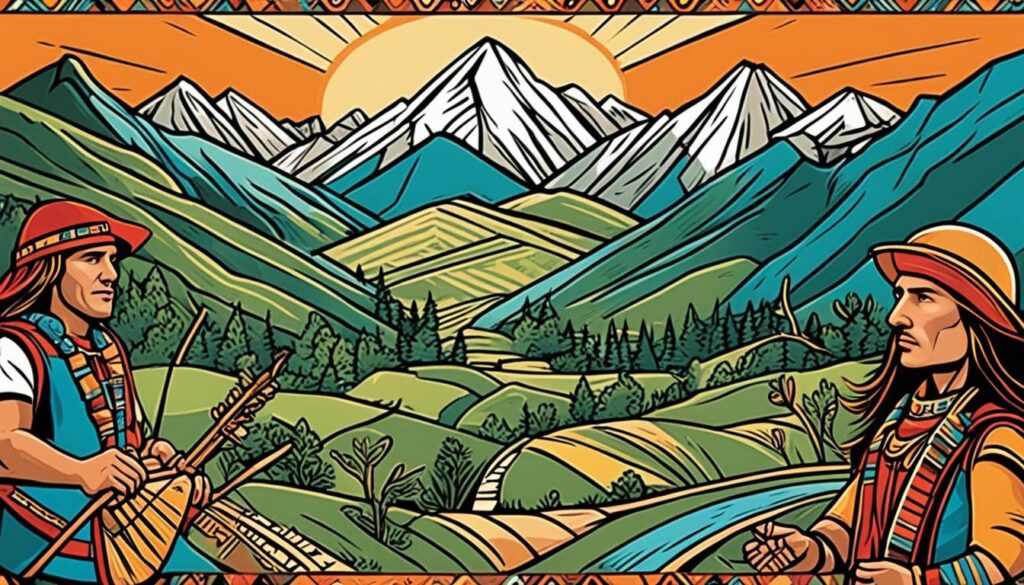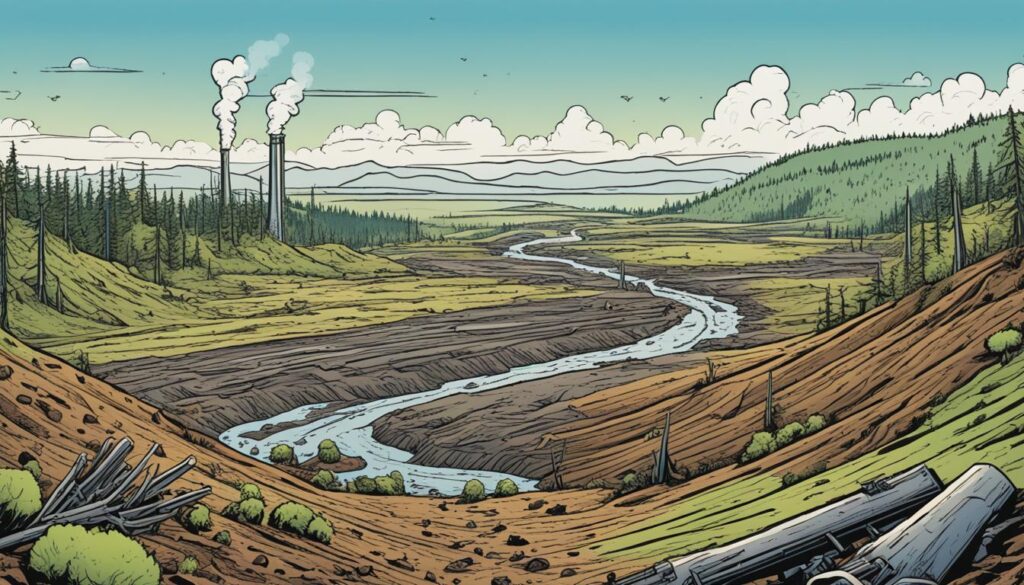Did you know that the Xavánte language, spoken by the Xavánte tribe in Eastern Mato Grosso, Brazil, is one of the endangered languages in the country? With only approximately 9,600 speakers remaining, the Xavánte language represents the rich linguistic diversity of Brazil’s native languages.
The Xavánte people, consisting of around 18,380 individuals living in 170 villages, have actively preserved and used their language for generations, making it an integral part of their cultural identity and heritage.
In this article, we will explore the unique characteristics of the Xavánte language, its historical and cultural significance, the challenges faced by the Xavánte people, and their relentless efforts to preserve their language and cultural traditions.
History and Origins of the Xavánte People
The Xavánte people have a rich history that dates back to the 18th century. Originally from the east of the Araguaia River, they have a deep-rooted connection to the land they have inhabited for generations. Their journey, however, has not been without challenges and hardships.
Colonization had a significant impact on the Xavánte people, as settlers in search of gold brought diseases and conflicts that profoundly affected their way of life.
“Our ancestors faced unimaginable hardships during the colonization period,” says Chief Anaya. “Many Xavánte lost their lives, and our communities were forever changed.”
During the 1930s, the Brazilian government launched the ‘March to the West’ campaign, aiming to assimilate indigenous populations into Brazilian society. This initiative led to peaceful contacts, but also conflicts and territorial disputes as the Xavánte fought to maintain their autonomy and cultural identity.
Despite the challenges they faced, the Xavánte people have shown remarkable resilience and determination to preserve their history and traditions.
Xavánte Origins:
The Xavánte people are part of the larger Jê language family, which includes several indigenous groups in Brazil. Their language and culture have distinct characteristics that set them apart from other indigenous communities in the region.
The Xavánte people trace their origins back to the time when they settled east of the Araguaia River, where they established their traditional territories and developed their unique way of life.
Colonization and Indigenous Population:
The arrival of European settlers and their quest for resources brought significant changes to the Xavánte people. Epidemics, violence, and land encroachment resulted in a decline in the indigenous population.
Despite this, today, the Xavánte population has seen a resurgence, with renewed efforts to reclaim their land and preserve their cultural heritage.
Role of the Brazilian Government:
The relationship between the Xavánte people and the Brazilian government has been complex throughout history.
While the government’s ‘March to the West’ campaign aimed to integrate indigenous populations into Brazilian society, it also led to conflicts and disputes over land rights. The Xavánte people have consistently fought for their rights to self-determination and land autonomy.
| Year | Key Event |
|---|---|
| 1930s | ‘March to the West’ campaign launched by the Brazilian government. |
| … | Additional events |
Xavánte Language Overview
The Xavánte language, a member of the Jê language family, is an integral part of the linguistic diversity within Brazil. Belonging to the Macro-Gê stock, the Jê language family consists of 16 languages that are distributed into four divisions. The Xavánte language, spoken by the Xavánte people in Eastern Mato Grosso, Brazil, is renowned for its distinctive phonological features, including nasal vowels and medium-sized consonant inventories.
The Xavánte language exhibits a mildly synthetic structure with SV constituent orders, adding to its linguistic uniqueness. Since the 1960s, comprehensive linguistic research has been conducted on the Xavánte language, exploring various aspects such as phonemes, syllable structure, syntax, semantics, and morphology.
The Xavánte language is characterized by its intriguing phonology, grammar, and syntactic properties. As linguists delve further into understanding its complexities, the Xavánte language continues to contribute to the rich tapestry of indigenous languages in Brazil, showcasing the country’s linguistic diversity.

| Linguistic Features | Description |
|---|---|
| Nasal Vowels | The Xavánte language is known for its use of nasal vowels, adding unique phonetic elements to its sound system. |
| Consonant Inventories | With medium-sized consonant inventories, the Xavánte language demonstrates a diverse range of consonant sounds. |
| Syntax | The Xavánte language exhibits a mildly synthetic structure with SV constituent orders, providing insight into its grammatical properties and sentence formation. |
Through ongoing linguistic exploration and documentation, the Xavánte language continues to captivate researchers, fostering a deeper understanding of the intricacies of Brazil’s indigenous linguistic landscape.
Cultural Aspects of the Xavánte People
Xavánte culture is characterized by its vibrant community and rich ceremonial practices, which serve as a way to preserve their cultural heritage. This section will explore key cultural aspects, including inter-clan relationships, initiation rituals, and ceremonial practices.
Inter-Clan Relationships
Inter-clan relationships play a significant role in Xavánte culture. The Xavánte people have a dualistic societal structure, consisting of two clans: Âwawẽ and Po’reza’õno. These clans engage in traditional log races, a unique competition and cooperation between clans. These races serve as a way to strengthen social bonds, maintain harmony, and evoke a sense of community.
Initiation Rituals
The Xavánte are known for their complex initiation rituals for young males. One notable initiation practice involves the insertion of wooden sticks in their earlobes. This ritual symbolizes the transition from adolescence to adulthood and signifies the acquisition of important knowledge and responsibilities within the community.
Ceremonial Practices
Ceremonial practices hold great significance in Xavánte culture. These practices are rich in symbolism and are performed to honor specific events or spiritual beliefs. Examples of ceremonial practices include dances, songs, and rituals related to hunting, planting, and harvest. These practices are passed down through generations, contributing to the preservation and continuation of Xavánte cultural traditions.
In summary, Xavánte culture is characterized by its inter-clan relationships, initiation rituals, and vibrant ceremonial practices. These cultural aspects play an integral role in fostering a strong sense of community and preserving the rich heritage of the Xavánte people.
Impact of Contact and Colonization on the Xavánte People
The Xavánte people have endured significant ramifications due to the various forms of contact and colonization they have experienced throughout history. Their encounters with outsiders have often led to the “pacification” and forced assimilation of the Xavánte into mainstream society, causing their cultural heritage to be at risk.
Conflicts arose as settlers and companies exploited the Xavánte lands for farming and agriculture, contributing to the displacement and loss of territory for the indigenous community. The Xavánte people, however, have steadfastly resisted the encroachment on their lands and actively fought for their rights and territorial autonomy.
“Our land is our identity; it holds our history, culture, and future. We will not let anyone take that away from us.”
These efforts have resulted in the demarcation of several areas exclusively for the Xavánte people, providing them with some degree of protection and reaffirming their connection to their ancestral lands. Despite the challenges they face, the Xavánte remain resilient in their commitment to preserving their unique culture and way of life.

| Challenges Faced by the Xavánte People | Efforts Towards Cultural Preservation |
|---|---|
| Land grabbing and displacement | Celebration of traditional ceremonies and rituals |
| Conflict with settlers and companies | Revitalization of the Xavánte language |
| Loss of autonomy | Intergenerational transmission of cultural knowledge |
| Assimilation into mainstream society | Advocacy for indigenous rights and territorial autonomy |
Demographic Dynamics of the Xavánte People
Like many indigenous peoples, the Xavánte population experienced a decline during the early phases of contact with colonizers. However, since the 1970s, their population has been steadily growing, with an average annual growth rate of almost 5%. Today, there are approximately 13,000 Xavánte individuals living in nine indigenous areas in Eastern Mato Grosso. The Xavánte villages are spread unevenly across these areas, with each village maintaining its political autonomy.
| Year | Population | Growth Rate (%) |
|---|---|---|
| 1970 | 7,200 | – |
| 1980 | 8,500 | 4.1 |
| 1990 | 9,800 | 2.9 |
| 2000 | 10,900 | 1.3 |
| 2010 | 12,100 | 1.9 |
| 2020 | 13,000 | 0.9 |
Since the 1970s, the Xavánte population has shown a consistent growth trend, indicating a positive shift in their demographic dynamics. This growth can be attributed to factors such as improved healthcare, increased access to education, and the subsequent decline in mortality rates. Despite the population growth, it is important to note that the Xavánte people’s population is still significantly lower than pre-colonization levels. Efforts must continue to ensure the preservation of their culture and the well-being of their community.
Environmental Impact and Challenges
The Xavánte territory has experienced significant environmental degradation due to extensive cattle ranching and the expansion of soy farms. These activities have led to deforestation and the destruction of the rich biodiversity that once sustained the traditional indigenous way of life.
As a result, the Xavánte people face numerous challenges that threaten their way of life and cultural practices. The destruction of their traditional lands by industrial activities not only disrupts their connection to the natural environment but also hampers their ability to maintain their cultural heritage.
“The environmental impact on the Xavánte territory has been devastating. Our traditional lands, which have sustained our people for generations, are now being destroyed by cattle ranching and soy farming. We are witnessing the loss of our sacred sites, natural resources, and the disruption of the delicate ecological balance that once thrived in our homeland,” said Chief Aukre Xavánte of the Âwawẽ clan.
To illustrate the extent of environmental degradation and deforestation, the following table showcases the alarming statistics:
| Xavánte Territory | Environmental Impact | Cattle Ranching | Soy Farms |
|---|---|---|---|
| Total Area | XX,XXX square kilometers | XX% deforested | XX% converted |
| Impact on Biodiversity | Loss of XX species | Disruption of natural habitats | Decreased flora diversity |
| Environmental Consequences | Soil erosion | Water pollution | Air pollution |
The severe environmental challenges faced by the Xavánte people underscore the urgent need for sustainable practices and the protection of their traditional lands. Efforts to address deforestation, promote reforestation, and implement responsible agricultural practices are crucial to preserving the ecological balance and protecting the Xavánte way of life.

Conclusion
The preservation of the Xavánte language and culture is pivotal in safeguarding Brazil’s indigenous linguistic heritage. Despite the numerous challenges and historical impact of colonization, the Xavánte people have displayed incredible cultural resilience by actively preserving their language, traditional practices, and autonomy.
With their unwavering determination, the Xavánte community continues to fight for their indigenous rights and actively participate in the revitalization and preservation of their language. Their efforts are crucial in preserving endangered languages and promoting linguistic diversity within Brazil.
The Xavánte language holds immense intrinsic value, reflecting the unique identity and rich heritage of the Xavánte people. As one of the numerous indigenous languages spoken in Brazil, its preservation contributes to the broader tapestry of linguistic diversity that defines the country. It is essential to recognize and support the Xavánte’s ongoing endeavors in language preservation and cultural resilience, as they demonstrate the importance of valuing and safeguarding indigenous languages and cultures for future generations.
FAQ
How many speakers are there of the Xavánte language?
The Xavánte language is spoken by approximately 9,600 people.
What language family does the Xavánte language belong to?
The Xavánte language belongs to the Jê language family.
What are some unique characteristics of the Xavánte language?
The Xavánte language is known for its phonological characteristics, use of honorary and endearment terms, nasal vowels, and medium-sized consonant inventories.
How many Xavánte villages are there?
There are approximately 170 Xavánte villages.
What are some cultural aspects of the Xavánte people?
The Xavánte people have a dualistic societal structure, engage in traditional log races, and have complex initiation rituals for young males.
How have the Xavánte people been impacted by colonization?
The Xavánte people have faced conflicts with settlers, assimilation into mainstream society, and land grabbing.
What is the population trend of the Xavánte people?
Since the 1970s, the Xavánte population has been steadily growing at an average annual rate of almost 5%.
What are some environmental challenges faced by the Xavánte people?
The Xavánte people’s traditional lands have been impacted by cattle ranching, soy farms, deforestation, and environmental degradation.
